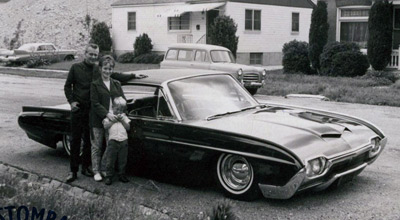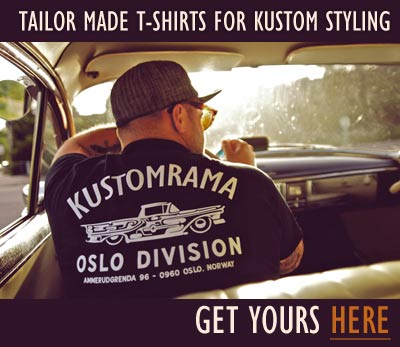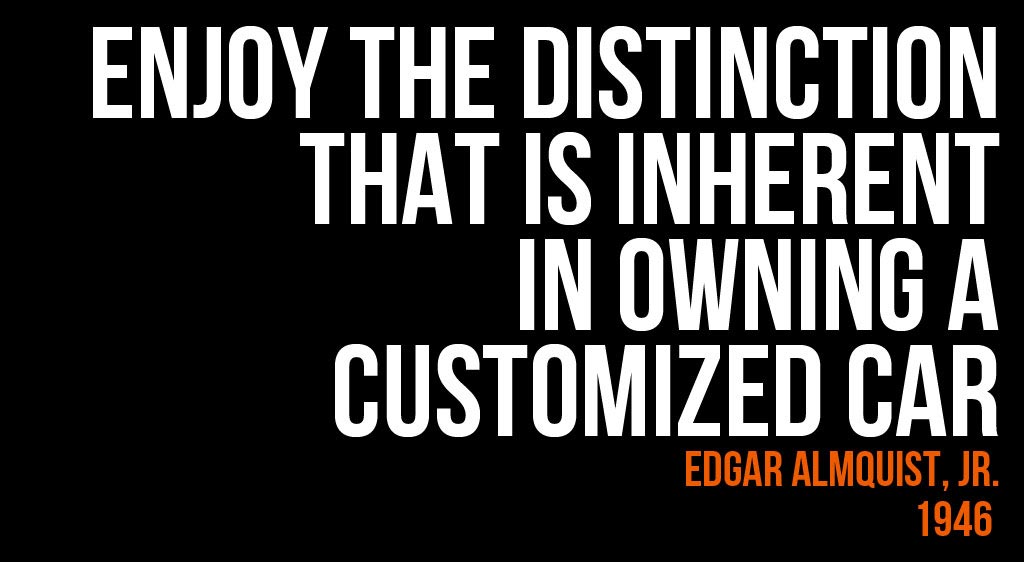Lowrider















low·rid·er: a customized car with a chassis that has been lowered so that it narrowly clears the ground.[1]
Custom cars have been around almost since the first motorcar took to the road. Most car owners were satisfied with their vehicles as they came from the manufacturer but for a few, there was a desire to enhance the appearance and/or performance of their automobile to suit their personal tastes. In the beginning, a customer would have the original builder or a specialty shop perform the modifications necessary to meet his or her particular needs and wants. The cost of this was considerable and a few brave souls undertook the work themselves. Either way, the end result was what is referred to as a "custom" car. By the 1920s and 1930s an increasing number of young people were applying custom touches to their everyday transportation and small shops were being established to supply the same work for those who didn't have the time or skill to do it themselves. The depression years nearly put a stop to the custom coach built luxury vehicle but the average person, working on a standard passenger car, continued to build sometimes very creative and elegant looking vehicles.[2]
After WW2 there was increased interest in all aspects of what was then known as the automotive "hobby", what we would call the car culture today. This included sports cars, racing, hot rods and, of course, custom cars. By the late 1940s nationally published magazines began to feature hot rods and customs and the word of what was primarily a Southern California phenomenon began to spread across the United States. This information was soon being put to use in other parts of the country with distant locales contributing their own unique ideas and traditions to the mix. By the early 1950s this new youthful auto culture was a part of everyday America, and the interest was so widespread that nearly every young male either drove or aspired to own and drive, a hot rod or custom car. Custom car and early lowrider historian Howard Gribble remembers growing up in a time when high school parking lots were filled with customs and rods in various stages of completion. "These cars had become truly a culture unto themselves."[2]
Contents
Bean Wagons
Meanwhile in Southern California WW2 and the booming economy that followed allowed a better life for those who had immigrated north from Mexico. There was now money for nicer cars and even for the custom modification of them. Though these Mexican/American youth were also attracted to other forms of the automotive hobby, such as hot rods, racing and motorcycles, the available evidence points convincingly to the fact that they had a particular interest in and affection for the custom car. Inevitably these Mexican/American kids would bring their own ideas and point of view to the custom car game. Early on they seemed to favor Chevrolet automobiles in particular. These vehicles would be modified with the same modifications seen on other custom cars of the day; shaved hood and deck lid, fancy hubcaps, modified exhaust, a custom stitched interior and paint in some color other than the original that had come on the car. A few after market accessories were often incorporated too, most notably dual spotlights and fenderskirts. More elaborate body modifications such as changed head and tail lights and the removal of the door handles were often seen as well. And a few went an even more radical route and chopped the top. In every aspect the Mexican/American's cars were pretty much like the rest of the custom cars seen cruising the streets. But there did seem to be one constant that stood out on these cars and that was the lowering of the vehicle's ride height above the road. The majority of the customs in those days were lowered but the Mexican/American kids seemed to embrace the concept and take it to a whole new level, which is to say a lower level. It was this look that would begin to define the Mexican/American style of ride and it was something they were proud to capitalize on and identify with. Of course it wasn't long before the rest of the youthful custom car enthusiasts took notice of this trend. And for the most part they didn't like what they saw. Some had legitimate concerns about the practicality of an automobile that lacked the ground clearance necessary to successfully navigate the public streets. But a good many others were motivated by prejudice and racism. They didn't like the radically lowered cars simply because they belonged to Mexicans. As a result by the late 1950s the white kids were calling any radically lowered sedan a "Bean Wagon" or "Taco Wagon". This pejorative term was of course derived from the perceived staple diet of the Mexican/ American kids and, insensitive though it was, it stuck. Pretty soon the term "Bean Wagon" came into wide spread usage, though seldom in the presence of owners of the vehicles being referred to![2]
African-American Car Clubs in Los Angeles
The history of African-Americans car clubs in Los Angeles begins with the gangs or clubs from the mid-1950s. These car clubs were started by African-American youth from the Westside and Eastside of South Central Los Angeles. The areas were blacks lived was South Central, Watts, and Compton. The Westside was the wealthier side of South Central and they were able to afford to buy cars. Some of the car clubs of that period lowered their cars and others imitated or put a spin on the white car clubs prevalent in Southern Calfornia at that time. Officer Horace DeJohn grew up when black gangs were in their infancy in 1950s South Central Los Angeles, played basketball at Jefferson High, went to Compton City College and then joined the LAPD shortly before the Watts Riots in 1965. In his book, Boot: An LAPD Officer's Rookie Year in South Central Los Angeles he mentions when black clubs later to be identified as gangs started creating car clubs:[3] "In the mid-1950s, black youngsters began to copy the Hispanic gangs which had been roaming the streets of East Los Angeles since the turn of the century. At the time having a car was everything for the gangster; they livened up their rides with chrome, wire wheels and brilliant paint jobs. Black kids saw them tooling around in their lowered rides getting the women, looking cool. So they started car clubs, using name like the Businessmen, the Orientals, Ghost Town, The Farmers and the Black Cobras. They cut their hair in jazz age style and wore lettermen's jackets with the name of their club on the back. They even divided their clubs along automobile lines; the Businessmen liked Buicks, the Farmers liked Chevrolets and Ghost Town took to Fords."[4]
Other African-American car clubs of that period and early to mid-1960s are : Low Riders, Coasters, Highwaymen, Road Devils, Gladiators, Slausons, Rebel Rousers, Huns, and the Blood Alley.[3]
Jim Logue and his Fabulous X54 - The First Hydraulic Lifted Car
In 1957, while working at the experimental department at North American Aviation, Jim Logue of Long Beach, California began installing hydraulic lifts on his 1954 Ford. In 2017 Jim told Sondre Kvipt of Kustomrama that he got the idea for the hydraulics from a Citroen. Citroen first introduced hydropneumatic suspension in 1954, on the rear suspension of the Traction Avant. The first four-wheel implementation was in the advanced DS in 1955. “Citroen used hydraulics to raise the car and go off-road. It was made to raise, so I did some reverse engineering to make it go low.” Jim thought of hydraulics to make the car practical on the street. “I didn’t have no money, so I used second-hand hydraulic parts from Palley Supply Company.” Palley’s was a war surplus store that sold hydraulic parts. “They had books on it, catalogs on how much, how big, how much stroke, and all this. I couldn’t buy hydraulic cylinders that would stick out the hood, so I had to do measuring and buying things they had that worked. I didn’t know what the catalog numbers were or anything, I just bought stuff I knew that I needed, pumps and everything.”[5]
California Vehicle Code 24008
In 1957 a law was passed by Governor Brown against lowered cars in California. The law, named the California Vehicle Code 24008, which wasn't enforced until 1958, outlawed any car having any part of the car lower than the bottom of its wheel rim. “They used to have a rollerskate that they would roll under your car with a stick to check the clearance,” Jim Logue told Sondre Kvipt.[5]
After some experimentation, a hydraulic system was deemed the best way to accomplish the task and cars began to appear on the street that could indeed be raised and lowered at will by flipping a switch. As might be expected this turn of events caught everyone's attention. The ground was now truly the only limit with any height in between easily attainable on demand. The new technology was more easily applied to the new breed of late model custom and it just plain looked cool to see a car sitting on the ground. Though the military surplus components of the hydraulic system were easy and relatively inexpensive to come by few adequately understood the principals of installation. It was kind of a black art at first but as more individuals got involved more cars were seen using the height adjustable hydraulic suspension. By the mid 1960s many of the better customs featured hydraulics and, though few realized it then, a new era was beginning.[2]
As hydraulics opened the door to a more versatile approach to lowering so too did it open the eyes of some former critics. Many of those who had criticized and dismissed the "Bean Wagon" now embraced the even lower stance of the lifted custom. In reality many of these same guys had secretly envied the low look for a long time and the advent of hydraulic lifts seemed, in their eyes at least, to lend it respectability and thus acceptance. But others were not convinced and driven by racial prejudice chose to heap ridicule on the new hydraulic lifted customs by labeling them in the "Bean Wagon" category too. It was even suggested, sometimes in jest and other times not, that some of the owners were themselves "White Beaners". By the mid 1960s relations between those cruising customs and the rest of the youthful car culture amounted at best to an uneasy truce.[2]
Bellflower Boys
As the 1950s gave way to the 1960s the interest in custom cars began to decline. There were several reasons for this but that is a subject for another discussion. In any event by the early 1960s the automotive press would all but banish customs from the pages of their publications. One reason for this was that the customs still being built were increasingly based on late model cars and featured less in the way of restyling and custom body work. Typically the newer customs relied on little more than fancy wheels, lowering and a trick paint job. They had custom embellishments but were still in the same basic configuration as they had been when they left the factory. This new look in customs had it's own following though and, in Southern California at least, a sizable number of people pursued it. Local car shows featured these colorful creations even if the print media failed to and the cars were regularly seen cruising the streets and drive-ins. The legendary custom painter Larry Watson was very much responsible for establishing this new style of custom and others followed his lead. While the white kids referred to Mexicans whit radically lowered cars as "Beaners", the Mexicans had a name for white kids with radically lowered cars as well. They called them "Bellflower Boys", and the term was often attributed to the white boys having more money.[2]
Where Does the Term "Low Rider" Originate From?
In the mid-1960s a new term appeared on the scene. No one today knows where the term "Lowrider", or "Low Rider", originated but most seem to agree that it succinctly defined the emerging custom car style of the day. It also had the added advantage of applying equally well to the owner/driver of those same vehicles. The word quickly began to gain widespread acceptance and by the end of the decade was firmly established among the youth of Southern California. It would take a few more years before the media would recognize and embrace lowrider cars, let alone the name, but that would come eventually. One thing was for sure though, "Lowrider" was far better than "Bean Wagon"![2]
The Watts Riots
According to Lowrider Magazine, the term was first coined by the police after the 1965 Watts Riots, and Jack Kennedy relates the following in the book Lowrider: History, Pride, Culture; "They (the police) were using the term “lowrider” as a derogatory term for the young black kids that were causing all the trouble.. They said that they were kids who drove cars with no springs and no seats so they could ride low."[3]
August 16, 1965 Eldridge Cleaver penned an essay while he was prisoned in the Folsom Prison. In the essay he mentions black inmates discussing the Watts Riots as lowriders; "As we left the Mess Hall Sunday morning and milled around in the prison yard, after four days of abortive uprising in Watts, a group of "low riders" from Watts assembled on the basketball court. They wearing jubilant, triumphant smiles, animated by a vicarious spirit by which they, too, were in the thick of the uprising taking place hundreds of miles away to the south in the Watts ghetto. "Man, said one, "what they doing out there? Break it down for me, They slapped each other's outstretched palms in a cool salute and burst out laughing with joy. Homeboy, them Brothers is taking care of business! shrieked another ecstatically. Then one low rider, stepping into the center of the circle formed by the others, rared back on his legs and swaggered, hunching his belt up with his forearms as he's seen James Cagney and George Raft do in too many gangster movies. I joined the circle. Sensing a creative moment in the offing, we all got very quiet, very still and others passing by joined the circle and did likewise."[6]
""Baby, he said, they walking in fours and kicking in doors; dropping Reds and busting heads; drinking wine and committing crime, shooting and looting;high-siding and low-riding, setting fires and slashing tires;"[6]
It is not known wether the term was coined by the Watts youth or the police, but it was associated with Watts black youth and their cars in 1965, and there even was a black Low Riders prison gang and car club that operated between 1967-1971.[3]
A Mexican Development
The late '60s and early '70s was a time of tremendous change in American society. The Vietnam War, recreational drugs, political assassination, the emergence of the hippy lifestyle and much more had a profound effect on the culture of America. There were many competing interests at work on the country's youth and for many of them, the automobile became less a means of individual expression and more of a simple conveyance. For some of the ecology-minded it even became the enemy. The custom lowrider automobile, never a huge part of the youthful automotive culture, maintained a surprisingly good bit of its popularity but it seems that the involvement of the white kids began to decline. The reasons for this aren't entirely clear but it is a fact. Interest in the lowrider, with its roots clearly traceable to the "Bean Wagon", was now primarily attributed to Mexican/Americans. It is interesting to note here that many of these die-hard lowriders had by now been in the game for a while and brought a more mature approach as well as more money. A more professional approach in the way they and their clubs presented themselves led to more media exposure. But by the time this began to happen the appearance and the reality of lowriding was that it was a Mexican thing. Others have gone as far as calling it a Mexican "invention" but actually, it is more of a development that occurred over several decades and involving huge contributions and influences by the Mexican/American community. By the 1970s they pretty much owned it.[2]
Lowrider Clubs
References
Did you enjoy this article?
Kustomrama is an encyclopedia dedicated to preserve, share and protect traditional hot rod and custom car history from all over the world.
- Help us keep history alive. For as little as 2.99 USD a month you can become a monthly supporter. Click here to learn more.
- Subscribe to our free newsletter and receive regular updates and stories from Kustomrama.
- Do you know someone who would enjoy this article? Click here to forward it.
Can you help us make this article better?
Please get in touch with us at mail@kustomrama.com if you have additional information or photos to share about Lowrider.
This article was made possible by:
SunTec Auto Glass - Auto Glass Services on Vintage and Classic Cars
Finding a replacement windshield, back or side glass can be a difficult task when restoring your vintage or custom classic car. It doesn't have to be though now with auto glass specialist companies like www.suntecautoglass.com. They can source OEM or OEM-equivalent glass for older makes/models; which will ensure a proper fit every time. Check them out for more details!
Do you want to see your company here? Click here for more info about how you can advertise your business on Kustomrama.







